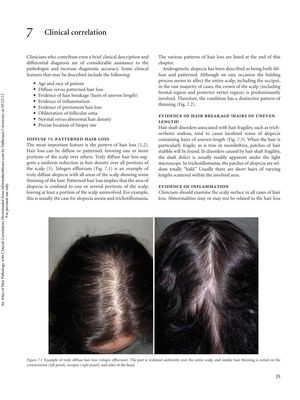Clinical Correlation: Importance of Detailed Descriptions and Differential Diagnoses for Hair Loss Conditions
April 2012
in “
Informa Healthcare eBooks
”
androgenetic alopecia trichorrhexis nodosa trichotillomania telogen effluvium alopecia areata cicatricial alopecia hair shaft disorders hair breakage inflammation follicular ostia hair density diffuse hair loss patterned hair loss male pattern baldness hair pulling disorder stress-related hair loss scarring alopecia

TLDR The conclusion is that detailed clinical descriptions help pathologists diagnose hair loss conditions more accurately.
The document emphasizes the importance of clinicians providing detailed clinical descriptions and differential diagnoses to assist pathologists in increasing diagnostic accuracy for hair loss conditions. It outlines various clinical features to be described, such as age, race, pattern of hair loss, evidence of hair breakage, inflammation, permanent hair loss, obliteration of follicular ostia, and hair density. Androgenetic alopecia is noted to typically present with a distinctive pattern of thinning at the crown, including the frontal and posterior vertex regions. Hair shaft disorders like trichorrhexis nodosa can cause localized zones of alopecia with uneven hair lengths, while trichotillomania typically results in patches of alopecia with short hairs of varying lengths. Diffuse hair loss, such as telogen effluvium, suggests a uniform reduction in hair density, whereas patterned hair loss, like alopecia areata and trichotillomania, is confined to specific scalp areas. Signs of cicatricial alopecia include wide spacing between follicles, tufting, and obliteration of follicular openings. The document also discusses conditions that may present with normal hair density despite complaints of thinning or shedding, and it lists various patterns of hair loss with examples, such as truly diffuse hair loss, patterned hair loss in androgenetic alopecia, and different forms of cicatricial alopecia.








